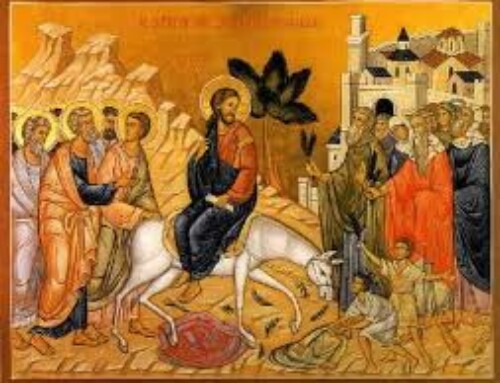Word Magazine December 1960 Page 4
THE POWER OF FAITH
By Subdeacon Michael I. Irvin
Delivered in St. Mary’s Church, Brooklyn, N.Y., March 27, 1963
In the Name of the Father, and of the Son, and of the Holy Spirit. Amen.
What a contrast for Our Lord—to come down from the mount on which He had just received the glory and power of His Father in the Transfiguration and to return to the quarrelling and strife of this world. The disciples of Christ had tried to cast out an evil demon and they had failed. The ever-present scribes immediately took the advantage and began to argue with the disciples, discrediting them in the eyes of the crowd. Suddenly, into the midst of this typically human bickering there appeared the Christ, with His face still shining from the Transfiguration. Although the glory shining in Moses’ face when he descended from Mount Sinai drove the people from him in fear, the glory shining from Christ’s face drew the people to Him —”when they saw Him, they were greatly amazed, and ran up to Him and greeted Him.” While Christ had been receiving the glory and power of Heaven, those disciples (and I fear we ourselves in today’s world, also entrusted with His mission had been procuring for Him only shame, distrust and unbelief, but He stopped the advance of the foes with the words, “What are you discussing with them?” The scribes and the disciples however did not find the courage to answer this query and so one of the multitude answered. He explained that his only son was possessed by a demon which often took hold of him and threw him to the ground, foaming at the mouth and grinding his teeth. The father had asked the disciples to cure the boy, but they had failed.
And then follows Christ’s rebuke —”O faithless generation, how long, am I to be with you? How long am I to bear with you?” St. John Chrysostom interprets these remarks as being directed to the multitude and not to only the disciples as Origen would have it. However, their lack of faith on the part of the disciples had reduced them to the level of the multitude of Israelites and so they must with them accept this condemnation. The second statement is not so much a declaration of longing to be free of this world but rather of a master who is complaining of the dullness and slowness of his students in their learning.
And then Christ asked to see the boy. As soon as the sick boy was brought into His presence, the evil spirit immediately possessed him in a convulsion. Such is always the case when the spirits of Satan are brought into the presence of the Lord of Creation, Christ Jesus. They cannot endure such purity and goodness, but immediately struggle and resist with all their might.
Christ inquires of the father how long the boy has had this affliction and the father takes the opportunity to fill in some more details of the history of the illness. He tells that the boy has been sick since childhood and that often he has almost lost his life by being thrown into water and fire because of his convulsions. He closes his account with a most significant statement: “if you can do anything, have pity on us and help us.” Note that the father uses the word “us”—undoubtedly to declare how completely his life tied up with that of his child. The phrase, “if you can do anything” not only shows his recent disappointment at the hands of the disciples but also that he did not come to Jesus with complete and unwavering faith. And so, it is necessary for Christ first of all to instill in the father a faith — a faith that a miracle could occur. The questions, as presented by Our Lord, is not “if I can do anything” but rather “if you can believe.” This is the hinge on which the entire miracle depends. After a short pause comes one of the most profound and moving statements of the entire New Testament — “All things are possible to him who believes.” The father, overwhelmed by the new faith welling up within himself, cries out with tears. “Lord, I believe.” and then, seeming to be quite aware of the abysmal depths of unbelief which still remain, the father adds,” help my unbelief!”
Now, nothing stood in the way of the all-powerful grace and mercy of Our Lord, and when He saw a crowd rapidly forming, He, wishing to avoid any excitement or agitation, immediately rebuked the spirit within the boy, exhorting it to come out. What majesty there is in the words, “I command you” and then to ensure the completeness and finalness of the cure, Christ gives the command “never enter him again.” Of course, the evil spirit must obey, but he does so most unwillingly. It seems as if he would destroy the boy since he can no longer possess him. In fact, the final fit was so powerful that everyone thought that the boy was dead, but Jesus took the boy by his hand and raised him up, whole and well and restored him to his father.
Then comes a crucial scene with the disciples when they enquire why it was that they were not able to cast out this demon. The Gospel of St. Matthew, in recording this same miracle, says that Christ replied, “Because of your little faith.” Only to faith are all things possible and only to a faith that is exercised by prayer and is always protected by rigor and self-denial.
And this is the very reason that the Orthodox Catholic Church observes the Great Lent. It is this period of fasting and prayer that should be used to increase our faith, making it strong and sure. We have already passed the half-way mark of our Lent, and it is time that we should re-evaluate our efforts. Have they been as severe as we can endure? We should never adopt the easiest way to follow but rather always the most strict that we can bear. Only in this way can we ever hope to make any spiritual progress. Have we been observing the fast as prescribed by Our Holy Mother, the Church and have we been faithful in our daily prayers and Bible readings? If not, then let us with firm resolution determine to discipline ourselves for the last two weeks of the Great Lent, for as St. John Chrysostom says in his glorious Easter sermon, “If any have toiled from the first hour, let him receive his due reward. If any have come after the third hour, let him with gratitude join in the Feast. And he that hath arrived after the sixth hour, let him not doubt: for he too shall sustain no loss. And if any have delayed to the ninth hour, let him not hesitate, but let him come too. And he that hath arrived only at the eleventh hour, let him not be afraid by reason of his delay; for the Lord is gracious and receiveth the last even as the first.” Yes. Our Lord will surely receive us all on Easter with joy and thanksgiving if we but sacrifice for Him as He sacrificed Himself for us on Calvary.
One evening a few weeks ago, the spiritual life of St. Mary’s of Brooklyn was enriched by the dedication of a shrine — a shrine to a great miracle-working icon — that of Our Lady of Saidenaya. And so let us with faith, prayers and fasting implore Our Lady of Saidenaya to aid us in our fight with Satan, asking Her that we may worthily end Lent and approach the joyous festival of the Life-giving Resurrection of Our Great God and Saviour Jesus Christ, to Whom be glory and honor, now and ever and unto ages of ages. Amen.



